Physical well-being
Physical well-being is a constituent of health as defined by the WHO in 1946: “Health is a state of complete physical, mental and social well-being and not merely the absence of disease or infirmity”. Physical well-being refers to the state of the body in which it functions efficiently and effectively, free from pain and constraint.
Urban microclimates can significantly affect physical well-being, both positively and negatively. One can think of the regulation of body temperature by sun and wind, the regulation of hormone levels by daylight, decreased lung function due to air pollution, uv-induced skin cancer, etc.
Thermal comfort
This chart draws the zone of outdoor thermal comfort for a person dressed in indoor clothing, sitting and/or doing very light work, in a situation without wind and direct solar irradiation. For any combination of dry-bulb temperature and relative humidity which falls inside the comfort zone no corrective measures are needed. For any point falling outside the zone, needed climate measures can be read from the chart.

The bioclimatic chart for the Netherlands adapted from Victor Olgyay (1963).
The figure shows the bioclimatic chart for temperate European climates. The closed curves represent the average 24-hour data of each month of the year for the Dutch situation.
From the chart it becomes clear that during the largest part of the year solar irradiation and wind shelter are needed. Only during the summer months some shade is needed. Wind is hardly ever needed according to the chart, but a breeze may be welcome during the warmest periods. Furthermore, some ventilation is needed to remove air pollutants.
As needs and preferences regarding thermal comfort differ from person to person, depending among other things on activity level, clothing and body shape, but also psychological aspects, outdoor spaces should offer both sun and shade in order for more people to feel comfortable. In summer more shade may be provided - also to provide protection from UV radiation, which can reach high levels in summer - , the rest of the year predominantly sunny spaces should be offered.
![]()
Solar radiation
Heat (air temperature and mean radiant temperature)
Too little heat (cold) can cause:
- hypothermia
- frost bite
- aggravation of cardiovascular, respiratory and cerebrovascular diseases
Too much heat can cause:
- heat stress (heat rash, heat cramps, heat syncope, thermal exhaustion, heat stroke)
- arterial and cerebral thrombosis
- aggravation of cardiovascular, respiratory and cerebrovascular diseases
UV radiation
Too little UV can cause:
- vitamin D deficiency, causing rickets, osteoporosis and osteomalacia.
too much UV can cause:
- sunburn
- accelerated skin ageing
- solar keratoses (thick, scaly, or crusty patches of skin)
- skin cancer (cutaneous malignant melanoma, squamous cell carcinoma of the skin, basal cell carcinoma of the skin)
- cortical cataract
- pterygium (a fleshy growth on the surface of the eye)
- cancer of the eye (squamous cell carcinoma of the cornea or conjunctiva)
The UV dose necessary for the adverse effects on skin and eye is much higher than the dose needed for vitamin D production which can be maintained by the intake of food. However, it is estimated that approximately 80-100% of vitamin D is derived from sunlight on the skin.
![]()
Daylight
Too little daylight can cause:
- disruption of the circadian melatonin and cortisol cycles, causing poor sleep quality, lack of alertness, feeling down, seasonal depression, immune deficiencies and possibly tumour growth
![]()
Wind
(Too much) wind can cause:
- convective cooling of the skin (positive in summer, negative in winter)
- disturbance of hair, flapping of clothes, difficulties holding umbrella (discomfort)
- balance problems (danger)
Some wind however is needed for the removal of air pollutants.
![]()
Air quality
Particulate matter (PM10/PM2.5) can cause:
- cardiovascular diseases
- respiratory diseases
- lung cancer
- aggravation of asthma, chronic obstructive pulmonary disease and cardiovascular diseases
Ozone (O3) can cause:
- lung inflammation
- decreased lung function
Nitrogen dioxide (NO2) is a marker for traffic related pollutants, which can cause:
- aggravation of bronchitic symptoms in children
- reduced lung function in children
Sulphur dioxide (SO2) can cause:
- decreased pulmonary and respiratory functions
![]()
Noise
Noise can cause:
- sleep disturbance (and therewith increased fatigue, depressed mood or well-being and decreased cognitive performance)
- annoyance
- stress
- hearing impairment